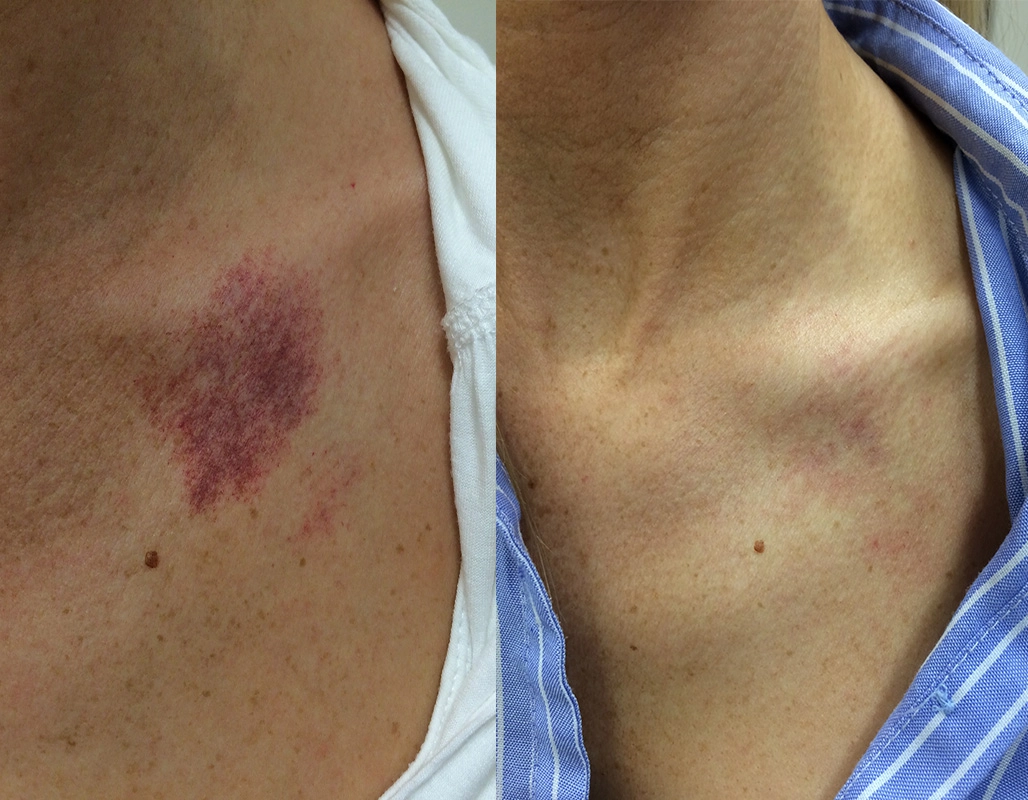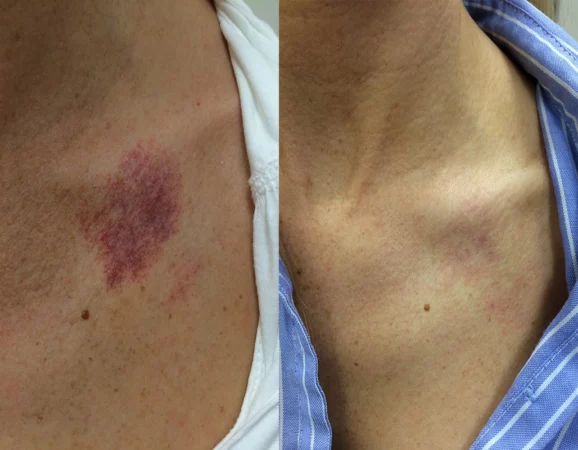Cutis Dermatology, Brisbane has experienced paediatric dermatologists to diagnose & treat all types of birthmarks, from neonate to adult patients. We treat patients privately & also at the Children’s hospital.
Cutis Dermatology offers a variety of active Birthmark treatment options.
- Vascular Lasers
- 微型激光器
- CO2 laser surgery
- Congenital moles
胎记治疗
Port wine stains & the latest vascular lasers
Cafe Au Lait Macules
Red birthmarks can be effectively treated with vascular lasers including the latest V Beam Prima & Derma V lasers. These lasers have dynamic cooling which is important for protecting the overlying skin. Birthmark treatments are partially covered by Medicare.
These brown birthmarks are a common cause of concern. Fortunately, they are easy to treat with the latest Picoway pigment lasers. Most cases will be removed within 1 to 3 sessions. These birthmarks grow in proportion to the child. They are best treated in adolescence. Treatments are partially covered by Medicare.
Diagnosis before treatment
Birthmarks in newborns
Dermatologists follow a diagnostic based approach to birthmarks. This means we identify the type of birthmark, including the level of involvement within the skin. In some cases we may order special imaging or perform a biopsy.
Did you know one in ten babies will have birthmarks? Most will resolve without any treatment. If you are concerned about marks on your newborn, book an appointment with our pediatric dermatologists. They can identify the type of birthmark & provide you with management options.
The first step in managing birthmarks is to get a firm diagnosis, from there we will formulate a treatment plan. In most cases, birthmarks can be erased with non-invasive lasers. Vascular lasers are used to treat red birthmarks, whilst pico lasers are employed to treat brown birthmarks.
常见问题
At what age should birthmarks be treated?
The optimal age depends on many factors, most importantly the type of birthmark. Some birthmarks including strawberry naevi & infantile haemangiomas should be treated early, whilst other forms such as congenital melanocytic naevi are treated later in life, most commonly adolescence.
Where do we treat birthmarks?
For older children, teenagers & adults, we treat birthmarks in our private room in Indooroopilly & Taringa, around 15 minutes from Brisbane’s CBD.
For neonates & babies we treat birthmarks at the Children’s Hospital. Dr Heba Jibreal will see birthmarks in younger children & will triage treatments accordingly.
What is an infantile haemangioma or strawberry naevus?
Strawberry naevus or an infantile hemangioma is a common benign vascular birthmark in children. It is noticed in the first few weeks of life.
How common are infantile haemangiomas?
This is one of the more common birthmarks, seen in one to three percent of newborns. They are more frequent in females compared to males.
Risk factors include preterm infants with a low birth weight. Maternal factors include multiple pregnancies & older or more mature mums.
What types of infantile haemangiomas are there?
They can be classified according to depth, namely superficial, deep & mixed. Another classification of these birthmarks includes their distribution pattern-
- Focal birthmarks — most common. Solitary, discrete, commonly head – neck.
- Segmental birthmarks — plaques in a patterned distribution commonly associated with local complications.
- Multifocal birthmarks – numerous localized haemangiomas distributed over more than one anatomic site.
- Indeterminate — the lesions are not definitively focal or segmental.
How do dermatologists diagnose strawberry naevi birthmarks?
In most cases it’s clinical findings as above. In some cases, we may order imaging including-
- Ultrasound
- MRI
- Other tests including endoscopic & histologic for more involved lesions
What is the most common complication associated with infantile hemangioma birthmarks?
Ulceration is the most common complication. This occurs in 16% of infantile haemangiomas around 3-4 months of age. Locations such as the nose tip, flexural & the anogenital areas are prone to ulceration & subsequent scarring.
Other high-risk sites include the ear, lips, nose, & areas of the lower face. Birthmarks in these locations require monitoring & in some cases more extensive investigation. Our paediatric dermatologists will liaise with paediatricians & ENT specialists for complex cases of infantile haemangioma.
How are infantile hemangioma birthmarks treated?
Treatment depends on the anatomic sites, & associations. Dermatologists will coordinate a team approach, liaising with your paediatrician. Treatments include-
- Oral propranolol — is the preferred low-risk non-surgical approach
- Topical timolol — for small birthmarks
- Pulse dye laser — for ulcerated residual birthmarks, after the proliferative period.
- Surgical intervention
What is a Becker naevi?
This is a common birthmark that increases in size & thickness during adolescence. It is triggered by hormones that increase hair growth, pigmentation, & thickness.
It is more frequent in males & is classically found on the shoulders, chest & back.
How can Becker birthmarks be treated?
This birthmark is hard to remove because it affects different layers of the skin, including the epidermis or surface, the middle dermal layer & deeper fat. Hyperpigmentation is resistant to lasers, whilst textural changes do not respond to lasers because it arises from deeper muscle fibres.
The biggest win for Becker nevus is to reduce darkly pigmented hair with hair removal lasers.
What is a sebaceous naevi birthmark?
This birthmark is relatively common. Dermatologists at Cutis will see a case every few weeks. It’s normally seen on the scalp & can present as a patch of hair loss or alopecia. This birthmark grows proportionally with the child but increases in size & thickness during adolescence.
It is best treated with surgery; however it can be debulked with lasers-especially in cosmetically sensitive areas. This birthmark can have foci of skin cancers within the lesion, & hence follow up with a dermatologist for life is recommended.
How do we treat angiofibromas due to neurofibromatosis?
NF or neurofibromatosis is a common syndrome seen by Cutis Dermatology, Brisbane. We treat angiofibromas topically, in addition to laser surgery. Redness can be decreased with vascular lasers, whilst lumps & bumps are treated with ablative erbium & CO2 laser resurfacing. Book a consultation with our paediatric dermatologists to discuss treatment options.
What is a stork mark birthmark?
This is one of the most common birthmarks, seen in over 40% of newborns. It affects the neck & fades with time. Persistent cases can be treated with vascular lasers; however most cases are covered with normal hair growth. This birthmark should not be confused with port wine stains.
What are the risks & associations of birthmarks?
Birthmarks may be associated with other systemic problems, namely rare syndromes. Examples include –
- Sturge-Weber syndrome – associated with a port-wine-stain birthmark on the upper eyelid and forehead, & abnormalities of the brain & eye.
- Klippel-Trenaunay-Weber syndrome – symptoms include a port-wine-stain birthmark on the leg with bone, muscles & soft tissue growth.
- Neurofibromatosis – symptoms including brown birthmarks, soft skin lesions, as well as eye & brain associations.
What are Mongolian spot birthmarks?
Mongolian spots are blue-gray birthmarks that usually are found on the bottom & lower back areas of newborns. They are very common in children of Asian, Hispanic, Pacific Island, or African descent. A child may have one or several Mongolian spots. Mongolian spots disappear without treatment by age 3 or 4. No treatment is required.
Why are congenital moles or melanocytic naevi resistant to lasers?
So, you have Googled that congenital mole can be treated with super powerful CO2 lasers, correct?
These birthmarks are resistant to even the most powerful lasers, including the Ultrapulse. We can get fading after 6-12 treatments but in most cases this birthmark recurs. The reason is that the reservoir of pigment cells is in the base of the hair follicle, namely in the deep fat layer. This is out of reach of lasers. Recurrence is the rule.
Can birthmarks be cancerous?
Most birthmarks are harmless. However, in some cases, they may develop into cancer. The risks depend on the type of birthmark, the size & age.
Children that are born with a very large congenital mole are at an increased risk of developing melanoma skin cancer. Sebaceous moles are also at risk of developing non-melanoma skin cancer. It’s important that a dermatologist regularly evaluates the affected skin for changes.
When is surgery a better option than lasers for birthmarks?
Lasers are better for CALM birthmarks & vascular or red birthmarks like port wine stains. Surgery is the treatment of choice for-
- Epidermal naevus birthmarks
- Congenital moles
- Sebaceous naevi
- Collagen & elastin naevi
What are rare birthmarks diagnosed by dermatologists?
Our dermatologists at Cutis Dermatology are involved in the diagnosis & management of super rare conditions, both in private practice & in the Children’s Hospital. We diagnose & manage conditions including aplasia cutis, collagenous naevi, incontinentia pigmenti, blue rubber bleb syndrome & over 150 more rare birthmarks.








